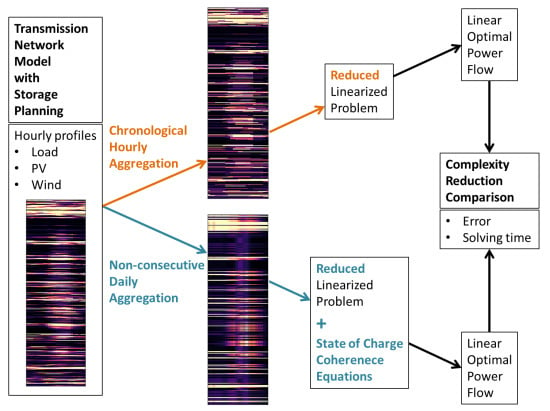Evaluation of Temporal Complexity Reduction Techniques Applied to Storage Expansion Planning in Power System Models
Abstract
1. Introduction
2. Literature Review
3. Methodology
3.1. Test case
3.2. Linear Optimization Power Flow
3.3. Time Series Aggregation Techniques
3.3.1. Data Preprocessing
3.3.2. Clustering
3.3.3. Data Rescaling
3.3.4. Adapting the Linear Problem
3.4. Indicators
3.5. Solver and Hardware
4. Test Case Optimization
5. Time Series Aggregation Efficiency
6. Time Reduction and Error
7. Influence of the Power Network Size
8. Influence of Parallel Computation
9. Conclusions
Author Contributions
Funding
Acknowledgments
Conflicts of Interest
Abbreviations
| AOE | average objective error |
| ATR | average time reduction |
| DLR-VE | German Aerospace Center—Institute of Networked Energy Systems |
| eTraGo | Electric Transmission Grid Optimization |
| LOPF | linear optimal power flow |
| MILP | mixed integer linear program |
| NEP 2035 | Netzentwicklungsplan 2035 |
| open_eGo | Open Electricity Grid Optimization project |
| OEP | Open Energy Platform |
| PyPSA | Python for Power System Analysis |
| TSAM | time series aggregation method |
References
- Poncelet, K.; Höschle, H.; Delarue, E.; Virag, A.; D’haeseleer, W. Selecting Representative Days for Capturing the Implications of Integrating Intermittent Renewables in Generation Expansion Planning Problems. IEEE Trans. Power Syst. 2017, 32, 1936–1948. [Google Scholar] [CrossRef]
- Nahmmacher, P.; Schmid, E.; Hirth, L.; Knopf, B. Carpe diem: A novel approach to select representative days for long-term power system modeling. Energy 2016, 112, 430–442. [Google Scholar] [CrossRef]
- Gabrielli, P.; Gazzani, M.; Martelli, E.; Mazzotti, M. Optimal design of multi-energy systems with seasonal storage. Appl. Energy 2018, 219, 408–424. [Google Scholar] [CrossRef]
- Kotzur, L.; Markewitz, P.; Robinius, M.; Stolten, D. Impact of different time series aggregation methods on optimal energy system design. Renew. Energy 2018, 117, 474–487. [Google Scholar] [CrossRef]
- Kotzur, L.; Markewitz, P.; Robinius, M.; Stolten, D. Time series aggregation for energy system design: Modeling seasonal storage. Appl. Energy 2018, 213, 123–135. [Google Scholar] [CrossRef]
- Tejada-Arango, D.A.; Domeshek, M.; Wogrin, S.; Centeno, E. Enhanced representative days and system states modeling for energy storage investment analysis. IEEE Trans. Power Syst. 2018, 33, 6534–6544. [Google Scholar] [CrossRef]
- Pineda, S.; Morales, J.M. Chronological time-period clustering for optimal capacity expansion planning with storage. IEEE Trans. Power Syst. 2018, 33, 7162–7170. [Google Scholar] [CrossRef]
- Priesmann, J.; Nolting, L.; Praktiknjo, A. Are Complex Energy System Models More Accurate? An Intra-Model Comparison of Poewr System Optimization Models. Appl. Energy 2019, 255, 113783. [Google Scholar] [CrossRef]
- Pfenninger, S. Dealing with multiple decades of hourly wind and PV time series in energy models: A comparison of methods to reduce time resolution and the planning implications of inter-annual variability. Appl. Energy 2017, 197, 1–13. [Google Scholar] [CrossRef]
- open_eGo Project. Available online: https://openegoproject.wordpress.com (accessed on 29 January 2019).
- PyPSA Github Repository. Available online: https://github.com/PyPSA/PyPSA (accessed on 29 January 2019).
- Bunke, W.-D.; Söthe, M.; Wingenbach, M.; Kaldemeyer, C. (Fl)ensburg (En)ergy (S)cenarios—Open_eGo Scenarios for 2014/2035/2050. Available online: https://osf.io/4a67n (accessed on 29 January 2019).
- eTraGo Documentation, rel. 0.7.0. Available online: https://etrago.readthedocs.io (accessed on 29 January 2019).
- Open Power System Data. Available online: https://data.open-power-system-data.org (accessed on 29 January 2019).
- Tennet TSO GmbH, 50Hertz Transmission GmbH, Amprion GmbH, and Transnet BW GmbH, Netzentwicklungsplan Strom 2025, Erster Entwurf der Übertragungsnetzbetreiber 2015. Available online: https://www.netzentwicklungsplan.de/sites/default/files/paragraphs-files/NEP_2025_1_Entwurf_Teil1_0.pdf (accessed on 29 January 2019).
- Elsner, P.; Erlach, B.; Fischedick, M.; Lunz, B.; Sauer, U. Flexibilitätskonzepte für die stromversorgung 2050: Technologien, szenarien, systemzusammenhänge, acatech—Deutsche Akademie der Technikwissenschaften e. V., Tech. Rep. 2016. Available online: https://www.acatech.de/wp-content/uploads/2018/03/ESYS_Analyse_Flexibilitaetskonzepte.pdf (accessed on 29 January 2019).
- Hörsch, J.; Ronellenfitsch, H.; Witthaut, D.; Brown, T. Linear optimal power flow using cycle flows. Electr. Power Syst. Res. 2018, 158, 126–135. Available online: https://doi.org/10.1016/j.epsr.2017.12.034 (accessed on 29 January 2019). [CrossRef]
- tsam Github Repository. Available online: https://github.com/FZJ-IEK3-VSA/tsam (accessed on 29 January 2019).
- Ward, J.H. Hierarchical Grouping to Optimize an Objective Function. J. Am. Stat. Assoc. 1963, 58, 236–244. [Google Scholar] [CrossRef]
- Merrick, J.H.; Weyant, J.P. On choosing the resolution of normative models. Eur. J. Oper. Res. 2019, 279, 511–523. [Google Scholar] [CrossRef]
- Gurobi Optimizer. Available online: https://www.gurobi.com (accessed on 29 January 2019).
- Fazlollahi, S.; Bungener, S.L.; Mandel, P.; Becker, G.; Maréchal, F. Multi-objectives, multi-period optimization of district energy systems: I. Selection of typical operating periods. Comput. Chem. Eng. 2014, 65, 54–66. [Google Scholar] [CrossRef]
- PyPSA-Eur Github Repository. Available online: https://github.com/PyPSA/pypsa-eur (accessed on 29 January 2019).
- Padua, D. (Ed.) Encyclopedia of Parallel Computing; Springer Science & Business Media: New York, NY, USA, 2011. [Google Scholar]
- Cao, K.-K.; Metzdorf, J.; Birbalta, S. Incorporating Power Transmission Bottlenecks into Aggregated Energy System Models. Sustainability 2018, 10, 1916. [Google Scholar] [CrossRef]
- Teichgraeber, H.; Brandt, A.R. Clustering methods to find representative periods for the optimization of energy system: An initial framework and comparison. Appl. Energy 2019, 239, 1283–1293. [Google Scholar] [CrossRef]

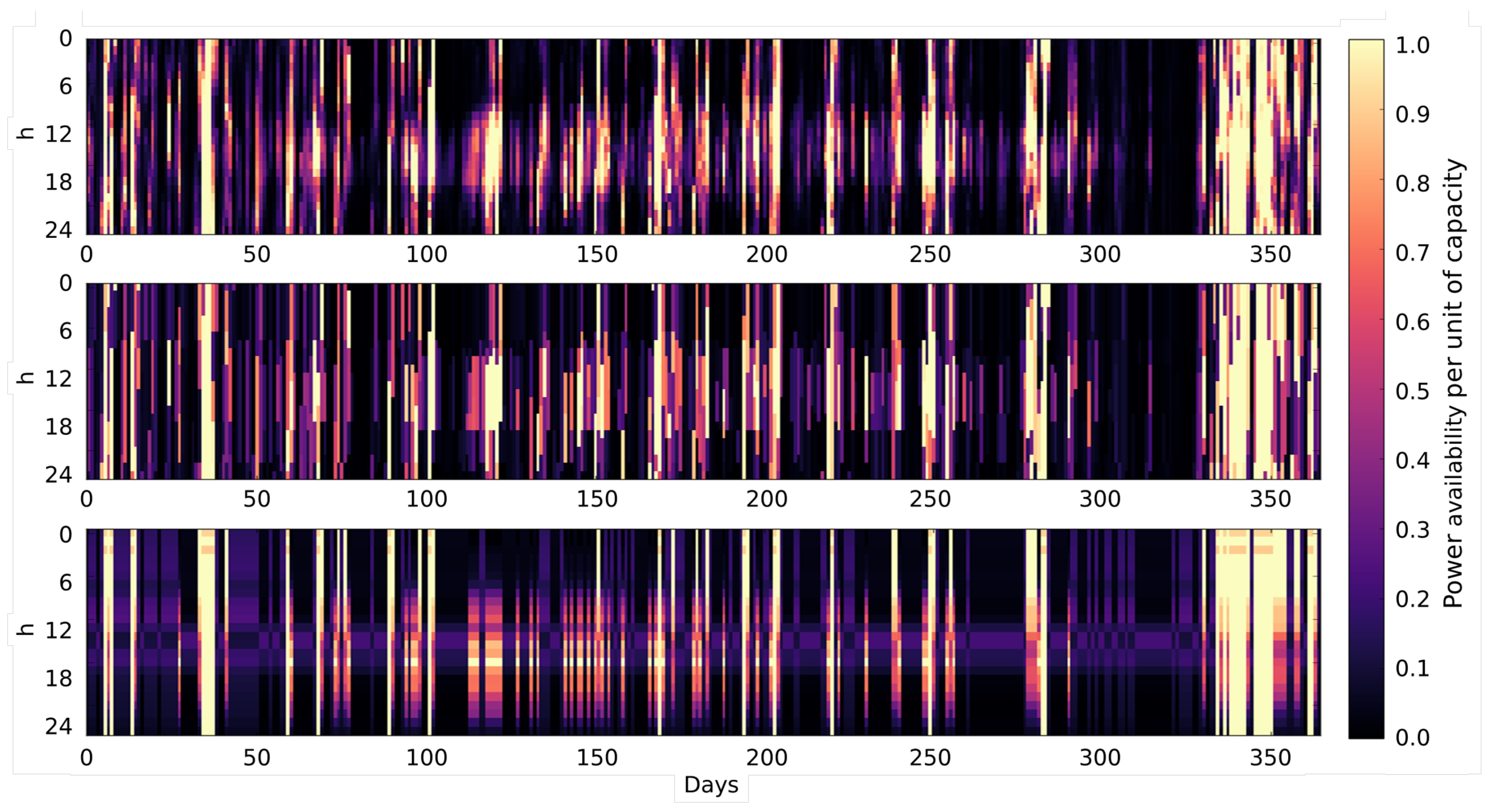
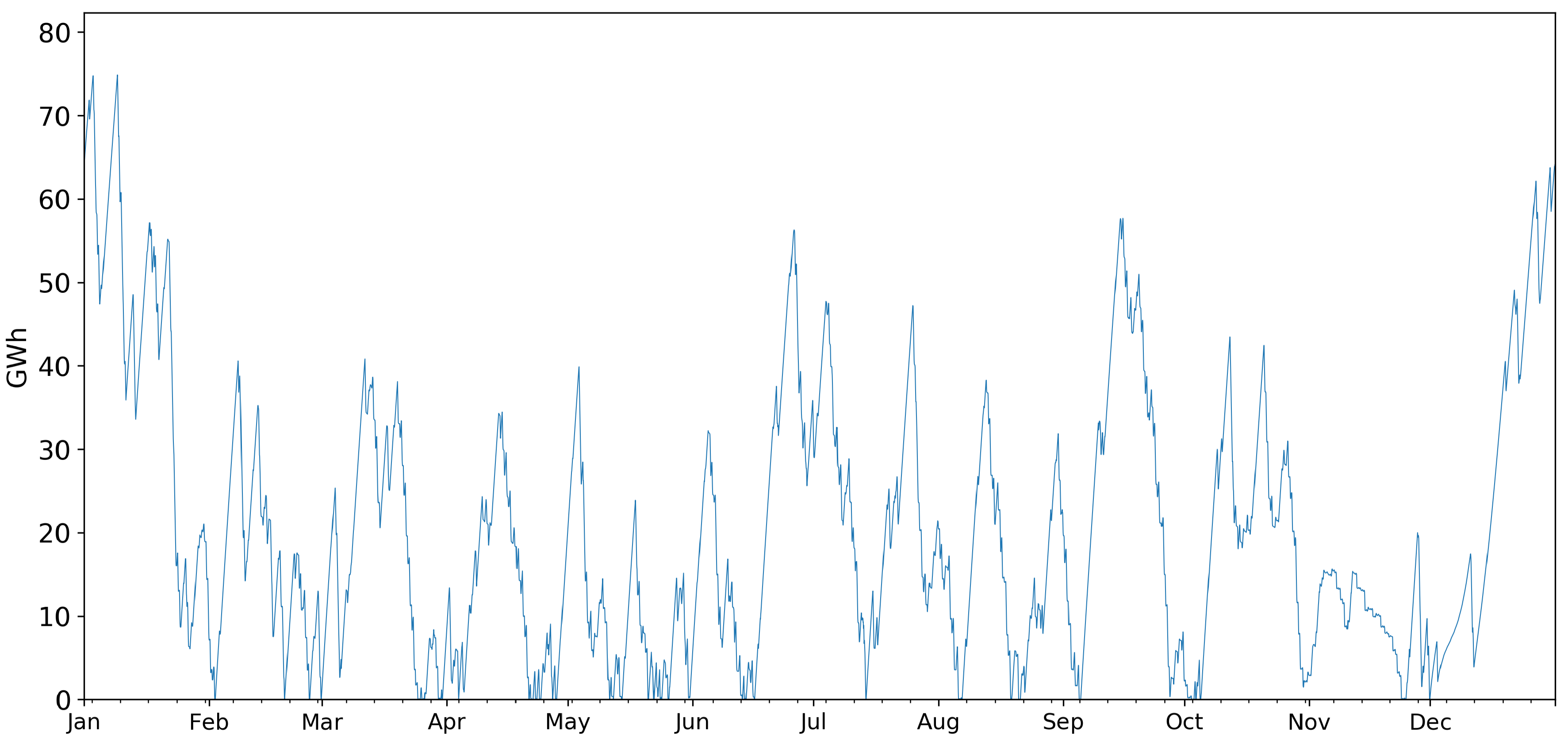


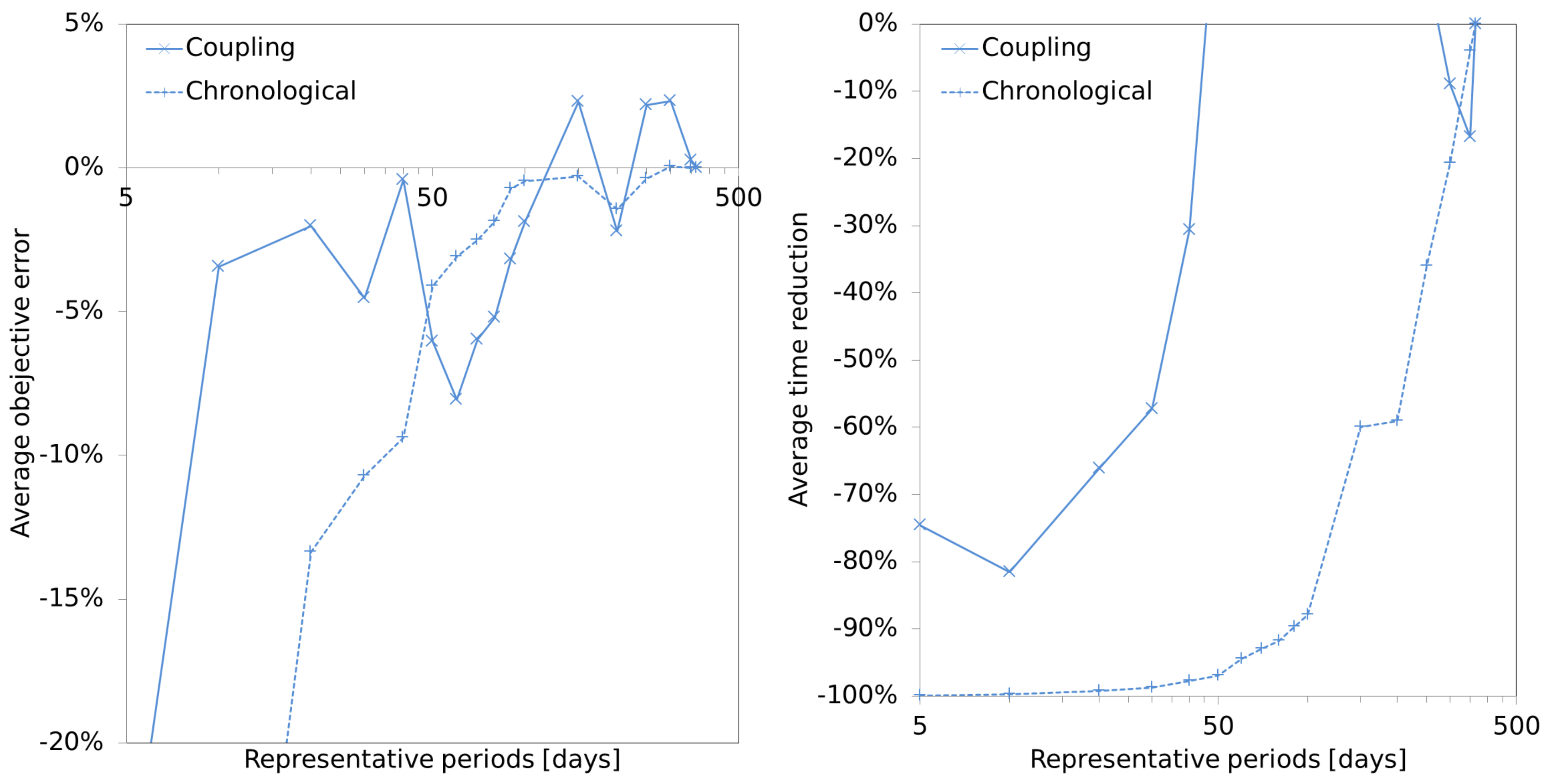


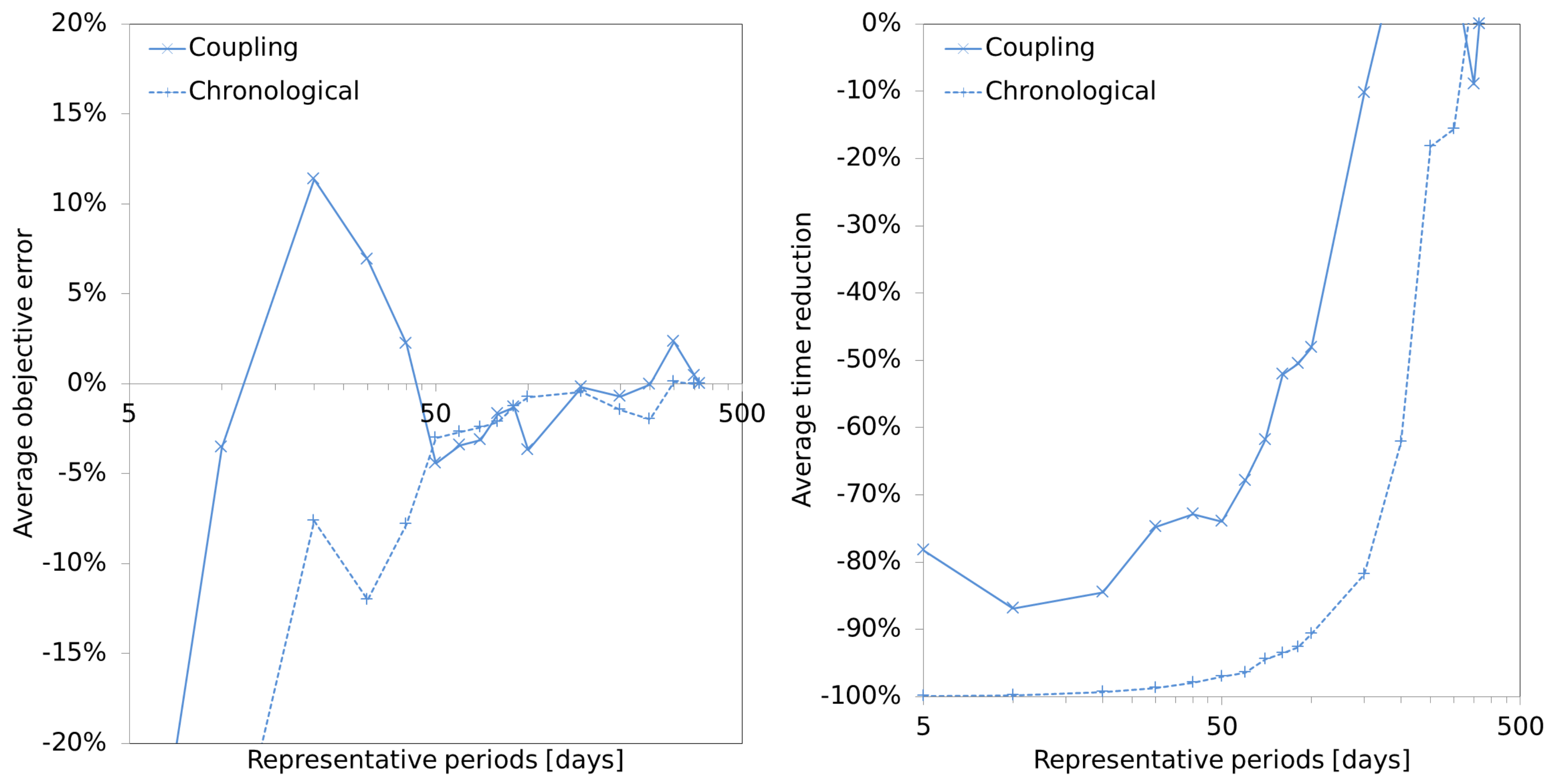

| Wind | Solar | Gas | Waste | Coal | Biomass |
|---|---|---|---|---|---|
| 15.56 | 2.57 | 0.68 | 0.05 | 0.27 | 0.5 |
| 79.17% | 13.13% | 3.49% | <0.01% | 1.36% | 2.56% |
| Component | Quantity | Characteristics |
|---|---|---|
| Buses | 152 | 380 (unified by the clustering) |
| Lines | 132 | between 182 and 3234 |
| Snapshots | 8760 | |
| Loads | 149 | |
| Generators | fixed capacity | |
| Biomass | 125 | / |
| Gas | 125 | / |
| Wind | 115 | 0 / |
| Solar | 146 | 0 / |
| Waste | 3 | / |
| Coal | 3 | / |
| Storage units | extendable up to 1 | |
| Batteries | 149 | 65,822 /, /, |
| 0.00694, 0.9327, | ||
| Hydrogen | 51 | 65,402 /, /, |
| 0.000694, 0.425, , |
| Definition | |
|---|---|
| bus label | |
| line label | |
| generator label | |
| storage unit label | |
| snapshot or time step | |
| weighting of a snapshot () | |
| generator dispatch () | |
| generator power capacity () | |
| , | minimum and maximum installable generator potential () |
| , | minimum and maximum generator power availability |
| operating cost of a generator () | |
| capital cost of a generator () | |
| voltage angle at a bus () | |
| power flow at a line () | |
| power rating at a line () | |
| K | incidence matrix |
| B | diagonal matrix of line susceptances |
| total active power injection at a bus () | |
| load () | |
| dispatch of a storage unit () | |
| power capacity of a storage unit () | |
| , | installable potential of a storage unit () |
| , | power availability per unit of storage capacity |
| operating costs of a storage unit () | |
| capital cost of a storage unit () | |
| state of charge of a storage unit () | |
| hours at nominal power to fill up a storage unit, i.e., energy to power ratio, (h) | |
| storage unit losses per hour | |
| efficiency of charge of a storage unit | |
| efficiency of discharge of a storage unit |
| Wind | Solar | Gas | Waste | Coal | Biomass |
|---|---|---|---|---|---|
| 9.49 | 1.38 | 0.22 | 0.05 | 0.92 | 1.19 |
| 71.58% | 10.40% | 1.65% | 0.41% | 6.96% | 9.00% |
© 2020 by the authors. Licensee MDPI, Basel, Switzerland. This article is an open access article distributed under the terms and conditions of the Creative Commons Attribution (CC BY) license (http://creativecommons.org/licenses/by/4.0/).
Share and Cite
Raventós, O.; Bartels, J. Evaluation of Temporal Complexity Reduction Techniques Applied to Storage Expansion Planning in Power System Models. Energies 2020, 13, 988. https://doi.org/10.3390/en13040988
Raventós O, Bartels J. Evaluation of Temporal Complexity Reduction Techniques Applied to Storage Expansion Planning in Power System Models. Energies. 2020; 13(4):988. https://doi.org/10.3390/en13040988
Chicago/Turabian StyleRaventós, Oriol, and Julian Bartels. 2020. "Evaluation of Temporal Complexity Reduction Techniques Applied to Storage Expansion Planning in Power System Models" Energies 13, no. 4: 988. https://doi.org/10.3390/en13040988
APA StyleRaventós, O., & Bartels, J. (2020). Evaluation of Temporal Complexity Reduction Techniques Applied to Storage Expansion Planning in Power System Models. Energies, 13(4), 988. https://doi.org/10.3390/en13040988




